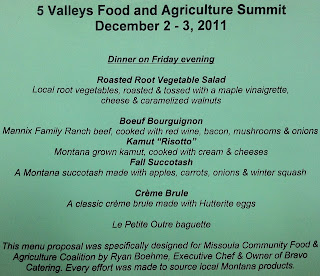Katie Wheeler is an MTCC AmeriCorps VISTA serving with the FoodCorps team in Kalispell, MT.
Jenny Montague, Kalispell District 5 Food Services Director, shares my vision of serving more healthy, locally-grown foods to kids. And even though this is her first year on the job, she’s already done amazing work, incorporating Montana beef patties, Flathead cherries, and local carrots, among other products, into school lunches and the Fresh Fruit and Vegetable program.
Jenny Montague, Kalispell District 5 Food Services Director, shares my vision of serving more healthy, locally-grown foods to kids. And even though this is her first year on the job, she’s already done amazing work, incorporating Montana beef patties, Flathead cherries, and local carrots, among other products, into school lunches and the Fresh Fruit and Vegetable program.
She’s ambitious, and wants to do even more. Recently,
though, she wrote an email exploring what’s holding her back. “The biggest
thing that keeps getting me with...[procuring] local food is our evident lack
of food processing ability, in the valley and within food service.”
Our five elementary schools lack full kitchens and all
lunches are made at Flathead High and then transported to the various
schools. Jenny went on to write,
“The raw foods themselves are completely affordable to buy locally - at least
the ones that are easier to grow here - squash, carrots, root vegetables,
etc.” For us, as far as I can
tell, it’s a matter of capacity: we don’t have the space or staff hours to add
in extra time to cut, peel or core produce, so it must be received already in
that form.
The building blocks for a local food system already exist,
and this October our schools served green bell peppers from a supply chain
succinctly captured in the picture below. From right to left is the farmer
(Harlequin Produce’s Kaley Hess), the aggregator (Western Montana Growers
Cooperative’s Jim Sugarek and Dave Prather), the processor (Karl Sutton of
Mission Mountain Food Enterprise Center), and the distributor (Jon Clarenbach
of Charlie’s Produce).
It all seems pretty flawless. Still, we need more models like these to really fill the
needs of our school district’s 5600 students.
One of the problems is that there are farmers north of
Kalispell who’d like to sell to the district, but for them to ship their
produce two hours or more to Ronan’s Mission Mountain Food Enterprise Center is
simply not practical. Jenny
described the situation best: “Many of the local Flathead farmers have
contacted me, and I am trying my best to represent everyone - however I am
missing a link. Either I need to
create a more substantial processing facility within food service, requiring
big investment in equipment and training labor - or a processing facility needs
to exist in Kalispell.”
To better explore this issue of the lack of processing and
local food infrastructure, I spent this past weekend at the first-ever Five
Valleys Food and Agriculture Summit, hosted by MMFEC and the Community Food and
Agriculture Coalition. The summit
brought together farmers, ranchers, processors, distributors, extension agents,
restaurateurs, professors, and local food advocates. Together we learned from examples of current partnerships,
met potential new stakeholders, and brainstormed ways to improve the system.
In the end, we didn’t solve the challenge of rebuilding a
local food system. We did,
however, make important connections with key players who can help us take more
steps in the right direction.
In fact, some of us have decided to host a similar meeting
in January to continue the conversation, particularly focusing on the needs of
our local schools. By working
together, we aim not only to change the menu in Kalispell District 5, but to
build a better food system for us all.
Two key factors for successful meetings: Great food. Great views.




Food Services Director, shares my vision of serving more healthy, survival warehouse food supplies locally-grown foods to kids. And even though this is her first year on the job,
ReplyDelete